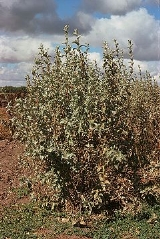
Elaeagnus commutata
Encyclopedia
Elaeagnus commutata is a species of Elaeagnus
native to western and boreal North America
, from southern Alaska
through British Columbia
east to Quebec
, south to Utah
, and across the upper Midwestern United States
to South Dakota
and western Minnesota
. It typically grows on dry to moist sandy and gravel soils in steppes, meadows or woodland edges.
These plants are shrub
s or small tree
s growing to 1–4 m tall. The leaves
are broad lanceolate, 2–7 cm long, silvery on both sides with dense small white scales. The fragrant flower
s are yellow, with a four-lobed corolla 6–14 mm long. The fruit
s are ovoid drupe
s 9–12 mm long, also covered in silvery scales. The fruit pulp is floury in texture, and surrounds the single seed
.
The species is cultivated as an ornamental plant
for its silvery foliage.
Elaeagnus
Elaeagnus , silverberry or oleaster, is a genus of about 50–70 species of flowering plants in the family Elaeagnaceae.The vast majority of the species are native to temperate and subtropical regions of Asia. Elaeagnus triflora extends from Asia south into northeastern Australia, while E...
native to western and boreal North America
North America
North America is a continent wholly within the Northern Hemisphere and almost wholly within the Western Hemisphere. It is also considered a northern subcontinent of the Americas...
, from southern Alaska
Alaska
Alaska is the largest state in the United States by area. It is situated in the northwest extremity of the North American continent, with Canada to the east, the Arctic Ocean to the north, and the Pacific Ocean to the west and south, with Russia further west across the Bering Strait...
through British Columbia
British Columbia
British Columbia is the westernmost of Canada's provinces and is known for its natural beauty, as reflected in its Latin motto, Splendor sine occasu . Its name was chosen by Queen Victoria in 1858...
east to Quebec
Quebec
Quebec or is a province in east-central Canada. It is the only Canadian province with a predominantly French-speaking population and the only one whose sole official language is French at the provincial level....
, south to Utah
Utah
Utah is a state in the Western United States. It was the 45th state to join the Union, on January 4, 1896. Approximately 80% of Utah's 2,763,885 people live along the Wasatch Front, centering on Salt Lake City. This leaves vast expanses of the state nearly uninhabited, making the population the...
, and across the upper Midwestern United States
Midwestern United States
The Midwestern United States is one of the four U.S. geographic regions defined by the United States Census Bureau, providing an official definition of the American Midwest....
to South Dakota
South Dakota
South Dakota is a state located in the Midwestern region of the United States. It is named after the Lakota and Dakota Sioux American Indian tribes. Once a part of Dakota Territory, South Dakota became a state on November 2, 1889. The state has an area of and an estimated population of just over...
and western Minnesota
Minnesota
Minnesota is a U.S. state located in the Midwestern United States. The twelfth largest state of the U.S., it is the twenty-first most populous, with 5.3 million residents. Minnesota was carved out of the eastern half of the Minnesota Territory and admitted to the Union as the thirty-second state...
. It typically grows on dry to moist sandy and gravel soils in steppes, meadows or woodland edges.
These plants are shrub
Shrub
A shrub or bush is distinguished from a tree by its multiple stems and shorter height, usually under 5–6 m tall. A large number of plants may become either shrubs or trees, depending on the growing conditions they experience...
s or small tree
Tree
A tree is a perennial woody plant. It is most often defined as a woody plant that has many secondary branches supported clear of the ground on a single main stem or trunk with clear apical dominance. A minimum height specification at maturity is cited by some authors, varying from 3 m to...
s growing to 1–4 m tall. The leaves
Leaf
A leaf is an organ of a vascular plant, as defined in botanical terms, and in particular in plant morphology. Foliage is a mass noun that refers to leaves as a feature of plants....
are broad lanceolate, 2–7 cm long, silvery on both sides with dense small white scales. The fragrant flower
Flower
A flower, sometimes known as a bloom or blossom, is the reproductive structure found in flowering plants . The biological function of a flower is to effect reproduction, usually by providing a mechanism for the union of sperm with eggs...
s are yellow, with a four-lobed corolla 6–14 mm long. The fruit
Fruit
In broad terms, a fruit is a structure of a plant that contains its seeds.The term has different meanings dependent on context. In non-technical usage, such as food preparation, fruit normally means the fleshy seed-associated structures of certain plants that are sweet and edible in the raw state,...
s are ovoid drupe
Drupe
In botany, a drupe is a fruit in which an outer fleshy part surrounds a shell of hardened endocarp with a seed inside. These fruits develop from a single carpel, and mostly from flowers with superior ovaries...
s 9–12 mm long, also covered in silvery scales. The fruit pulp is floury in texture, and surrounds the single seed
Seed
A seed is a small embryonic plant enclosed in a covering called the seed coat, usually with some stored food. It is the product of the ripened ovule of gymnosperm and angiosperm plants which occurs after fertilization and some growth within the mother plant...
.
The species is cultivated as an ornamental plant
Ornamental plant
Ornamental plants are plants that are grown for decorative purposes in gardens and landscape design projects, as house plants, for cut flowers and specimen display...
for its silvery foliage.

